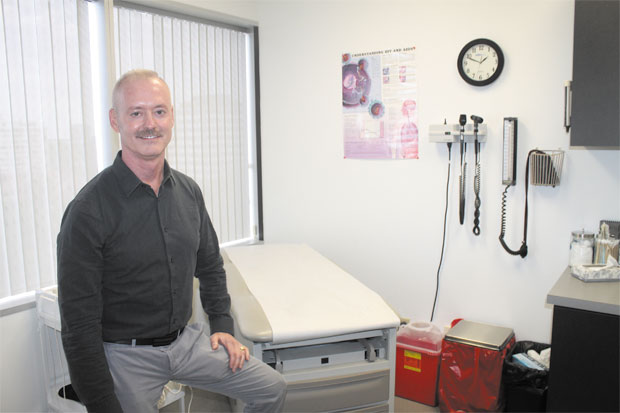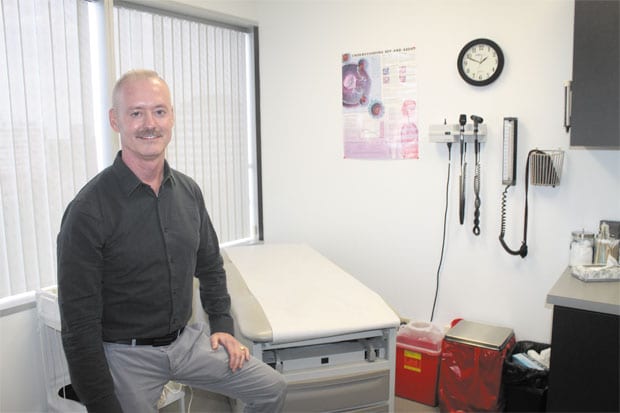Dr. Steven Pounders, the first healthcare provider to win BTD’s Kuchling Award, helped bring Dallas through the early days of the AIDS epidemic

DAVID TAFFET | Senior Staff Writer
 Dr. Steven Pounders began medical school the year the Morbidity and Mortality Weekly Report first reported that young gay men were dying of several rare diseases. He arrived at Parkland Hospital in 1988, just as Dallas Gay Alliance settled a lawsuit forcing Dallas County to fund the purchase of AZT, the only drug known at the time to help fight the HIV virus.
Dr. Steven Pounders began medical school the year the Morbidity and Mortality Weekly Report first reported that young gay men were dying of several rare diseases. He arrived at Parkland Hospital in 1988, just as Dallas Gay Alliance settled a lawsuit forcing Dallas County to fund the purchase of AZT, the only drug known at the time to help fight the HIV virus.
Pounders’ specialty was internal medicine, and he was assigned to the “AIDS floor” right away. It was a time when orderlies were leaving meals outside the door of hospital rooms housing patients with AIDS, and nurses were afraid of any direct contact with AIDS patients.
Some of Parkland’s doctors back then were definitely homophobic, Pounders said, afraid to perform any invasive medical procedure on a patient with AIDS. What have become routine precautions — such as wearing a mask or gloves when treating a patient — were unheard of at the time.
It was so bad that if a patient needed to go down to x-ray, Pounders took them himself.
Sound familiar?
Think back to the 2013 film Dallas Buyers Club, which centered around Ron Woodroof, an Oak Lawn resident diagnosed with AIDS in 1986 who then began traveling to Mexico and elsewhere to obtain experimental drugs for himself and other people with AIDS living in Dallas. The character of Dr. Eve Saks? That character was based on Steven Pounders, the real doctor who actually helped administer the drugs Woodroof brought back to the people who needed them.
Woodroof was the plaintiff in the DGA case that forced Parkland to provide medication to people with AIDS, the one that was being settled when Pounders began working at Parkland. Woodroof’s attorney was Don Maison, who has been CEO of AIDS Services Dallas ever since then.
Pounders said that in real life, he never treated Woodroof at Parkland. It wasn’t until after he went into private practice that Woodroof became one of his patients.
“Brady Allen wooed me away from Parkland,” Pounders said, adding that it was after he went into private practice with Allen that Woodroof contacted him and became his patient. Their relationship, Pounders said, was turbulent: “I fired him.”
The doctor recalled that Woodroof liked guns and would bring them to the doctor’s office. Pounders told him the first time not to bring another gun to the office. When Woodroof did it again, Pounders told him not to come back.
Woodroof sent Pounders roses (in the film, Woodroof sends Garner’s character a picture of roses) and Pounders took him back — with the understanding he wouldn’t bring guns back to the office.
Parkland had given Woodroof little chance of surviving a year, but under Pounders’ care and with the alternative medications — whether they had any effect or not — Woodroof lived about seven more years.
Beyond Woodroof
But Pounders work with AIDS patients certainly wasn’t confined to Ron Woodroof.
Pounders was one of the first local doctors to begin recommending, once an HIV test became available, that patients not take the test anonymously. If the test came back positive, he told his patients, there was little treatment available, but it could prompt their insurance to drop their coverage.
While Pounders was still at Parkland, he said, the hospital began installing TB lights — lights that “kill things [that cause tuberculosis] in the air” and a variety of other illnesses spread from one person to another, especially if those people had compromised immune systems.
“At one time, I had 40 people on IV drips at home,” Pounders recalled. “I had 12 people in the hospital every day. In 1990, ’91, ’92, I had at least one death a week.”
He even opened an infusion clinic upstairs from his office to administer drugs intravenously so his patients could avoid hospital visits.
Over the next few years, Pounders’ practice became haven where people with HIV could go to try experimental drugs that, between 1995 and 1997 cut the death rate of people with AIDS by half.
But since that time, Pounders’ practice has changed dramatically.Today, he has no HIV/AIDS patients in the hospital. While some of his patients are on drug trials, he said, the studies are for high blood pressure medication or diabetes management.
Today, Pounders’ patients are more likely to worry about problems related to aging than HIV. He said he spends his time advising patients on exercise, controlling their weight and eating well.
But the transition was difficult. What began as a practice that helped manage opportunistic infections ultimately resulting in the death of many of his patients became one where people lived. So he has ended up in a practice that treated three times the usual number of patients, but brought in only about one-third the money.
He hired one physician’s assistant, and then another, so he could handle the larger case load. Since he no longer needed an infusion clinic to administer a variety of drugs, he didn’t need to rent as much space, which saved some money.
And finally, Pounders, who studied internal medicine, became a primary care physician.
His practice today
What’s new in Pounders’ practice today? Aesthetics. He said he enjoys working with patients who’ve lost facial fat, helping them regain a healthy look.
“It’s artistic,” he said, and when people look better, they’re more likely to go out in public and more likely to take better care of their health in general.
And, he said, “Staying healthy helps prevent chronic diseases.”
Does he prescribe PrEP, the preventative drug regimen intended to help HIV-negative people remain HIV-negative. “Constantly,” Pounders said. “More people need to be on it.”
He mentioned one European study that shows promise that intermittent use of PrEP may be just as effective as a daily dose. That involves using just four pills — two the day before a date, one 24 hours after and another 48 hours after any sexual contact.
But keep those condoms handy, Pounders warned.
“The rates of gonorrhea and syphilis are soaring,” he said. And gonorrhea is becoming resistant to the antibiotics used to treat it.
Recognition
This weekend, Dr. Pounders will become the first healthcare provider to receive the Black Tie Dinner’s Kuchling Humanitarian Award. He will be at the dinner at the Sheraton Dallas Saturday night, Oct. 1, to receive the award with his partner of 20 years, Jimmy O’Reilly, at his side.
He is, he said, tremendously honored to receive the recognition.
“I was shocked to be included in the list of Kuchling Award winners,” he said, “especially John Thomas, who I knew and took care of and who succumbed to the epidemic in 1999. I was always inspired by his great leadership.”
And from now on, Pounders’ name will be on that list, a man that others have — and will continue to — look to for leadership and inspiration.
……………..
Fun facts about the doctor
• Dr. Steven Pounders loves cars and has an enviable collection. One, a 1993 Roll Royce, belonged to Juanita Miller, who once owned Highland Park Village along with her husband, Henry Miller. When Pounders acquired the car, he said, the only scratches on it were from Juanita Miller’s fingernails at the door handles.
• When he was 13, Steven Pounders competed in the Van Cliburn piano competition in Fort Worth. He also played the oboe and concentrated on that in high school. While attending Austin College in Sherman, he played oboe with the Sherman Symphony Orchestra.
• Dr. Pounders has a collection of cartoon cels and drawings displayed throughout his office. All of them have a medical theme.
This article appeared in the Dallas Voice print edition September 30, 2016.

